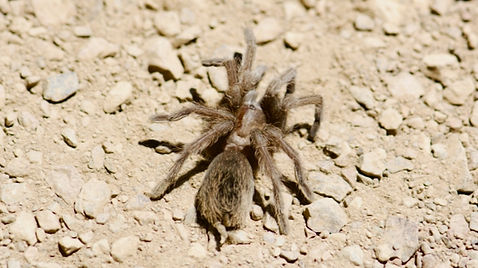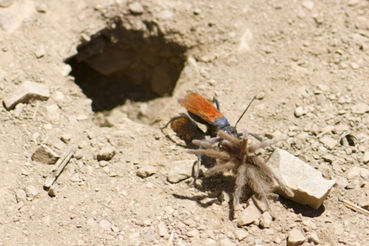Pepsis Tarantula Hawk Has Found Its Prey
by Dan Sandri
You do not want to get stung by this one!
July 5, 2025

A Desert Tarantula (Aphonopelma iodius) sits paralyzed, as a Pepsis Tarantula Hawk looks for a nest burrow. By Dan Sandri
After keeping an eye out for years, I finally encountered a Pepsis wasp with its prey item in Mount Diablo State Park: a Desert Tarantula (Aphonopelma iodius)! While most of us “Mount Diablo-philes” have a great love for our local tarantulas, I am also enamored with Tarantula Hawks – those large, magnetic blue-black wasps with the orange wings!
By the way, I have not been stung by a Tarantula Hawk, as I very much treat them with the respect they deserve (Pepsis grossa is one of just 3 insect species to have been given a Schmidt Pain Scale rating of 4, the highest pain rating, by University of Arizona Entomologist Dr. Justin O. Schmidt. Yes, he tested the pain levels!). He described the pain by writing that “screaming is satisfying and helps reduce attention to the pain of the sting” – a pain that is “instantaneous, electrifying, excruciating, and totally debilitating.” No thank you!
So, I watched with a mixture of sadness and exhilaration as the Tarantula Hawk dragged the already paralyzed spider off a grassy hillside and along the trail ahead of me. I didn’t see the capture. Given that it is early July, it is very likely that the Pepsis wasp (identified by its wing venation) found the tarantula in its burrow and coaxed it out or forced it out by entering the burrow. Alas, there was likely no epic battle, as I don’t think the Tarantula Hawks ever lose. Interesting to me, however, is the fact that, if it is true that the tarantula was in its burrow, the Pepsis wasp didn’t use the tarantula burrow as the nest for its larva that will slowly feed on the still-alive spider. They have been known to use the tarantula burrow or to find their own burrow.
It chose to drag the spider along the trail and stopped to check out two pre-existing burrows on the trail, deciding on the second one as the home for its egg-larva-pupa. The larva will feed on the non-vital parts of the tarantula first, grow steadily, before finishing off the spider, pupating, and will likely emerge as an adult wasp next year.
Once it dragged the tarantula into the burrow, I stood over the burrow for over an hour, with camera at the ready, but the wasp didn’t come out. I suspect that it had a lot of cell construction, tunnel-filling, and back-filling work to do to make this gopher/snake hole a home. And for me, like Tom Petty sang, it was:
... time to move on, time to get going
What lies ahead, I have no way of knowing...





